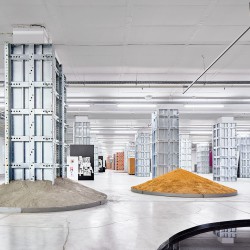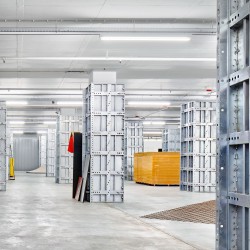architecten de vylder vinck taillieu . MAIO . Ricardo Bak Gordon . + divisare
Ongoing exhibition at the CCB, curated by Amélia Brandão Costa and Rodrigo da Costa Lima.
Until October 14th, 2018.
One objective of Garagem Sul is to explore the act of construction with reference to architectural practice and its social reflections. The exhibition Building Stories, presented in the Summer of 2018 in this context, was per se a conversation around this topic. The exhibition space was occupied as an open landscape, populated with fragments of ideas and materials that offered visitors unusual perspectives on the nature of architectural practice. Curators Amélia Brandão Costa and Rodrigo Costa Lima insisted on the concept of landscape: “the intent was to transcend the limits of the museum space and focus on architecture as a discipline.”
The Barcelona-based practice Maio doubled the garage structural grid by overlapping the existing columns with form-works and, in relation to these, distributing a new set of formworks which ultimately transformed the scale and the perception of the entire space. Lisbon-based architect Ricardo Bak Gordon built a one-to-one brick model of a house currently under construction. With the walls kept unfinished at various heights, its ongoing expression creates the feeling of a maze, with models and drawings being displayed over the house’s rough materiality. De Vylder Vinck Taillieu, from Ghent, introduced materials “as such” into the space, dispersing within Maio’s formworks and Bak Gordon’s bricks several piles of materials required to build a house.
These materials become monuments of the banal, emanating the magic to be found when wandering through construction sites. Tomás da Cunha Ferreira conceived a unique soundscape to fill the silent garage space with a novel atmosphere. All these contributions were complemented with a collective effort of documentation and representation of building sites throughout the world, with short films that confirm the shared nature of building throughout architectural culture. The exhibition addressed a far-reaching and long-debated question in architecture around the completeness and incompleteness of construction. An architectural work is never completed, with further usage, appropriation and wearing being an ongoing part of our material world. There can be no such thing as the crystal-clear image of a building newly-delivered by the contractor. Ultimately, architecture is the continuous transformation of materiality.
André Tavares
_
·
Building Stories is an exhibition about what cannot be easily perceived at first glance in architecture: how architecture is produced and built. Despite the construction process being just one aspect of a building, it forms the leitmotif of this exhibition, allowing us to understand architecture as a complex global whole. To build is an opportunity and this is often the main goal in architecture. In order for us to grasp this state of mind, the exhibition is therefore presented en brut, with its rawness transporting us to the foundations, to the continuous back-to-the-future which is a feature of every new project.
Building Stories is the representation of an abstract landscape made up of architectural fragments. Like a permanent construction site, it emphasises the dimensions of the exhibition space as if it was a piece of land or a contemporary industrial ruin where it is easy to imagine the cold smell of fresh cement and the sound of heavy machinery. The intent is to transcend the limits of the museum space and focus on architecture as a discipline. Building Stories ranges from the scale of the territory to the one-to-one, pursuing the architect’s imaginary. Achievements, turning points or simply notes and desires from architecten de vylder vinck taillieu, Maio and Ricardo Bak Gordon are shown as live expressions of a much larger universe. The exhibition thus establishes a conversation between these architects who – despite each having their own ideas, methods and formal expression– share architecture as a common ground, weaving their individual and unique approaches together. architecten de vylder vinck taillieu present ‘architecture as such’: pre-packaged materials deployed as they arrive on the building site as readymade monuments. These monuments are then set in a new grid like sculptures spread in a landscape. A kind of ‘architecture in parts’ that is a re- flection of the exquisite complexity of the work of these Belgian architects. MAIO work on the existing structure to define a new grid for an entire space in which stories take place. The repetition of columns forms a new order and suggests an unending format. The used concrete formworks and process images shown over panels present us an urban culture that denies permanency.
This paradox is at the heart of an architecture in which time and permanency are central issues. Ricardo Bak Gordon builds the Blue House project currently under construction in Grândola: a real physical expression of something not yet built or misplaced. The divisions of the house bring to the exhibition a classical model for the presentation of architecture. Projects of built houses thus far are distributed throughout the Blue House and exhibited with drawings, sketches and models. The exhibition challenges the visitor to perceive life and architecture through the work of the three different architectural practices, showing the similarities that can be found between stories when we speak about architecture. Building Stories is a celebration of architectural practice. Parts of projects are built on site to full scale, while building processes are shown and drawings, sketches, images and films are presented to the public to reveal the final outcome of stories. A sound installation by artist Tomás da Cunha Ferreira will add another layer to the physical experience of the exhibition space, enriched with a film piece gathering contributions from many architects who were willing to share their own Building Stories.
Amélia Brandão Costa and Rodrigo da Costa Lima
_




















